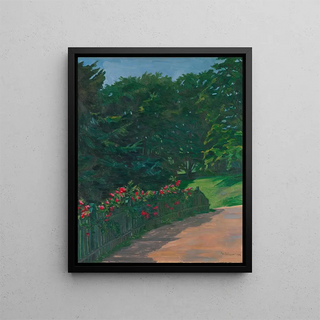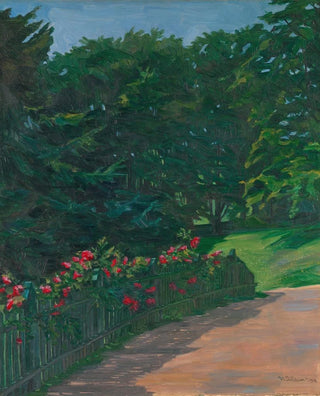Art print | Rose hedge - Wilhelm Trübner


View from behind

Frame (optional)
Art print Haie de rosiers - Wilhelm Trübner – Captivating introduction
In the fascinating panorama of 19th-century German art, "Haie de rosiers - Wilhelm Trübner" stands out for its elegance and delicacy. This artwork, which evokes a lush garden, transports the viewer into a universe where nature and art blend in perfect harmony. Trübner, through this canvas, manages to capture not only the beauty of the roses but also the essence of a suspended moment, where time seems to stand still. The atmosphere emanating from this creation invites contemplation and daydreaming, making each glance a unique and immersive experience.
Style and uniqueness of the work
Wilhelm Trübner's style is characterized by a realistic approach enriched with impressionist touches, which give his works a rare emotional depth. In "Haie de rosiers," vibrant colors and play of light are used masterfully, creating a striking contrast between the dazzling roses and the green foliage surrounding them. Each petal appears alive, each shadow plays a role in the composition, adding an almost tactile dimension to the whole. Trübner excels in the art of nuance, and this canvas is a perfect example, where the subtleties of nature are rendered with remarkable finesse. The structure of the work, both simple and complex, allows the viewer to immerse themselves in a world where floral beauty is celebrated in all its splendor.
The artist and his influence
Wilhelm Trübner, born in 1851, is an emblematic figure of German art, whose influence still endures today. Trained at the Academy of Fine Arts in Munich, he successfully combined tradition and modernity, aligning with the realism movement while incorporating elements of impressionism. His work is marked by a constant quest for authenticity and truth in the representation of the natural world. Trübner also played a key role in the development of landscape art, encouraging many artists to explore themes of nature and light. "Haie de rosiers" bears witness to this passion for nature, but also to his desire to capture moments

Matte finish

View from behind

Frame (optional)
Art print Haie de rosiers - Wilhelm Trübner – Captivating introduction
In the fascinating panorama of 19th-century German art, "Haie de rosiers - Wilhelm Trübner" stands out for its elegance and delicacy. This artwork, which evokes a lush garden, transports the viewer into a universe where nature and art blend in perfect harmony. Trübner, through this canvas, manages to capture not only the beauty of the roses but also the essence of a suspended moment, where time seems to stand still. The atmosphere emanating from this creation invites contemplation and daydreaming, making each glance a unique and immersive experience.
Style and uniqueness of the work
Wilhelm Trübner's style is characterized by a realistic approach enriched with impressionist touches, which give his works a rare emotional depth. In "Haie de rosiers," vibrant colors and play of light are used masterfully, creating a striking contrast between the dazzling roses and the green foliage surrounding them. Each petal appears alive, each shadow plays a role in the composition, adding an almost tactile dimension to the whole. Trübner excels in the art of nuance, and this canvas is a perfect example, where the subtleties of nature are rendered with remarkable finesse. The structure of the work, both simple and complex, allows the viewer to immerse themselves in a world where floral beauty is celebrated in all its splendor.
The artist and his influence
Wilhelm Trübner, born in 1851, is an emblematic figure of German art, whose influence still endures today. Trained at the Academy of Fine Arts in Munich, he successfully combined tradition and modernity, aligning with the realism movement while incorporating elements of impressionism. His work is marked by a constant quest for authenticity and truth in the representation of the natural world. Trübner also played a key role in the development of landscape art, encouraging many artists to explore themes of nature and light. "Haie de rosiers" bears witness to this passion for nature, but also to his desire to capture moments






